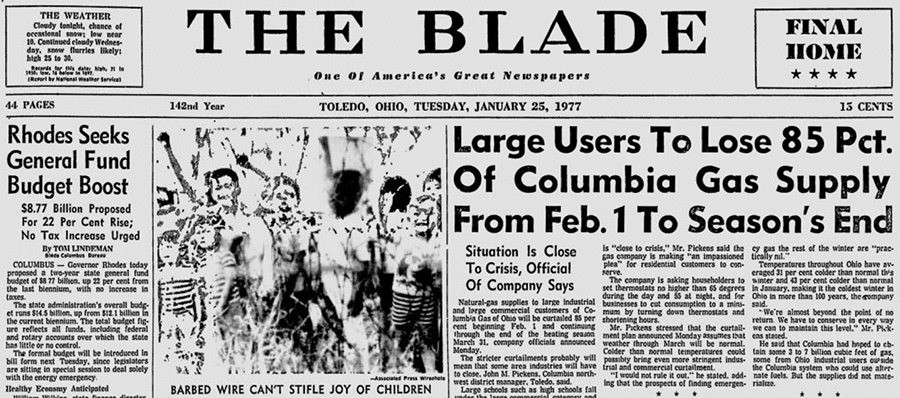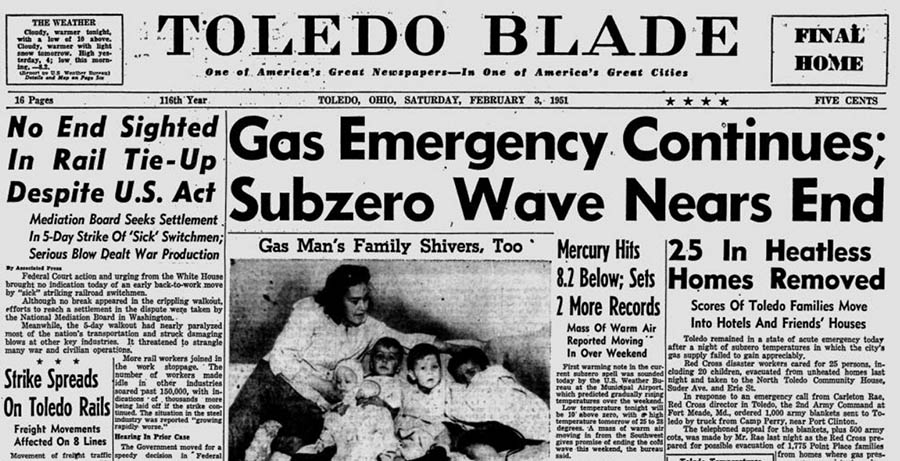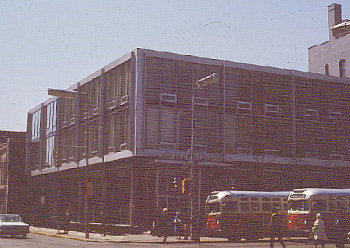The winter of 1976-77 was particularly cold in northwestern Ohio. Between Christmas, 1976 and early February, 1977 – a stretch of 45 days – the temperature never got above freezing at the official reporting station at Toledo Express Airport.
As homes, business and schools tried to stay warm that winter, a combination of high natural gas usage and low supply put much of Toledo, and Ohio as well, in a perilous situation.
The shortage kicked off on January 10, when an explosion at the Columbia LNG Corp. synthetic gas plant at Green Springs, southeast of Fremont, put the plant out of operation. It represented a potential loss of 2.5 billion cubic feet of gas a month to Columbia Gas of Ohio. This news came on the same day Toledo was hit with approximately eight inches of snow.
On January 13, the mercury hit fifteen below.
Four days later on January 17, the temperature hit 15 below yet for the second time in three days. Columbia Gas asked about 2,400 commercial and industrial customers to remain closed and asked residents to lower their thermostats to 65 in an effort to conserve fuel. Libbey-Owens-Ford gave its 2,600 workers unpaid days off and Jeep halted a day shift and cancelled much of its night shift. Most area school districts closed.
“Scattered area industries shut down for the day in response to the utilities’ appeal, but a check of major stores and shopping centers showed that business was proceeding pretty much as usual,” The Blade said. The group manager for Sears in Toledo said his stores actually use less gas when open, because of the heat generated by customers, back in the days when Sears had customers.
The synthetic gas plant in Green Springs, meanwhile, had resumed operation, but at only 25% capacity. When temperatures soared into the 20s on January 19, officials curtailed their conservation requests – but only temporarily.
With the threat of more cold temparatures looming, officials of sixteen member school systems in the Penta County vocational district met January 20 with legislatures, and representatives of Columbia Gas, on how their districts could best cope with the shortage and got unhelpful answers like “I don’t have any answer for you. I wish I did,” and “I don’t know any of the answers and I’m not going to pretend that I do.”

Things hit rock bottom that winter on January 25, when Columbia Gas, facing a major supply shortage and record usage in subzero weather, announced that “large users” would see an 85% supply drop until the end of the season. Large users could be anyone from industries to shopping centers to school districts, which sent all three into a tizzy about what to do. I distinctly recall many rumors flying around my district, Sylvania, about what might happen: consolidating buildings, running day/night schools, and so forth.

The superintendent, Dr. Richard Ziehmer, told The Blade “it was doubtful” the district could stay open as five of the system’s 12 buildings were affected. The Springfield Local superintendent said that without any relief from the state Legislature, “there is no way to remain open.”
So, if I recall correctly, we had a couple weeks off instead of starting classes at Arbor Hills Junior High School at 4 p.m.
Two days later, Columbia Gas called for over 500 of the state’s major users to shut down because of more impending cold weather. The next day, most schools in Northwest Ohio were closed (meanwhile, Maumee Valley Country Day School decided to start holding classes on the sixth floor of the old Secor Hotel).
The effort worked, however. A day later, after blizzard conditions paralyzed the region, Columbia Gas said the picture had brightened considerably because of conservation efforts. Pipeline pressure rose considerably the previous day, a Friday, apparently the result of widespread business closings around noon.
The Blade sent out Wanda Cook that Saturday to survey Toledo’s curtailed shopping scene:
Like sinners knocking at the gates of heaven, disappointed shoppers rattled the doors of closed stores Saturday, peering in disbelief through unlighted shop windows.
“I had my mouth all set for a bagel sandwich,” a disgruntled Howard Dotson, Wildwood Avenue, said as he turned away from the locked-up Bagel Place in The Pillars on Heatherdowns Boulevard.
In Southland Shopping Center almost the only stores open Saturday were supermarkets, a bakery where the buns were rising and business was slow, and a state liquor store.
“If we’ve got to freeze, we might as well freeze happy,” liquor store customer Dick Zablocki, of the 500 block of South Detroit Avenue, said.
The request was extended into the week of Jan. 31.
Any failure to comply with that request (now an order) would cause Columbia Gas to discontinue their service. The Toledo Public Schools found that out after their superintendent, Frank Dick, sent a telegram saying Toledo schools planned to reopen (which they did, for one day). The object of the order, backed by the Public Utilities Commission of Ohio, was to preserve as much gas as possible for residential customers.
The situation eased on Feb. 3 when emergency gas supplies started flowing from west to east. Toledo Public Schools eventually found their own source of gas and, in fact, started selling it to other school districts. Most districts reopened the week of Feb. 7.
Interestingly, this was not the first time this type of shortage had happened. 1951 was particularly memorable in the same way.

Featured image is the Columbia Gas Co.’s former building downtown at Jefferson and Erie with the added bonus of a pair of 1960s Community Traction buses.
